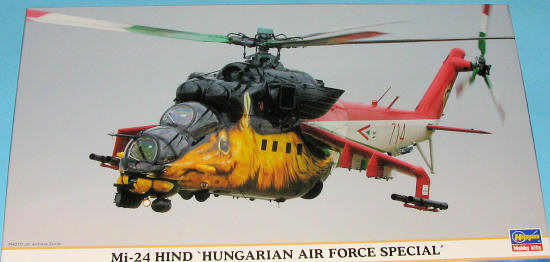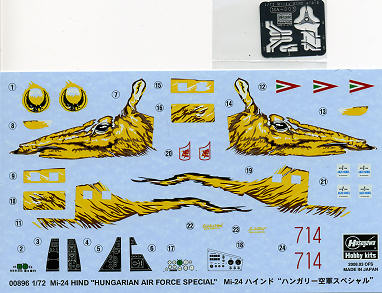
Hasegawa 1/72 Mi-24 Hind 'Hungarian Air Force Special'
| KIT: | Hasegawa 1/72 Mi-24 Hind 'Hungarian Air Force Special' |
| KIT #: | 00896 |
| PRICE: | $33.00 MSRP |
| DECALS: | one option |
| REVIEWER: | Scott Van Aken |
| NOTES: | Reissue with fresh decals |

| HISTORY |
The Mil Mi-24 (Cyrillic Миль Ми-24, NATO reporting name "Hind") is a large helicopter gunship and low-capacity troop transport produced by Mil Moscow Helicopter Plant and operated from 1972 by the Soviet Air Force, its successors, and over thirty other nations.
In NATO circles the export versions, Mi-25 and Mi-35, are simply denoted with a letter suffix as "Hind D" and "Hind E" respectively. Soviet pilots called the aircraft "letayushiy tank" (flying tank). Another common nickname is "krokodil" (crocodile), due to the helicopter's camouflage and fuselage shape
Flight tests with a prototype began on 15 September 1969 with a tethered hover, four days later the first free flight was conducted. A second prototype was built, followed by a test batch of ten helicopters.
Acceptance testing for the design began in June 1970 continuing for 18 months. Changes made in the design addressed structural strength and fatigue problems, and reduced vibration levels. Also, a 12 degree anhedral was introduced to the wings to address the aircraft's tendency to Dutch roll at speeds in excess of 200 km/h, and the Falanga missile pylons were moved from the fuselage to the wingtips. This gave the helicopter its characteristic wings. The tail rotor was moved from the right to the left side of the tail, and the rotation direction reversed. The tail rotor now rotated up on the side towards the front of the aircraft, into the downwash of the rotor, which increased efficiency of the tail rotor. A number of other design changes were made until the production version Mi-24A (izdeliye 245) entered production in 1970 and obtaining its IOC in 1971. It was officially accepted into the state arsenal in 1972.
In October 2007, defense-aerospace.com reported the government of Saudi Arabia signed a contract for up to 150 Mi-35 and Mi-17 helicopters worth $2.2 billion.
In October 2007, the Russian Air Force announced it will replace its 250 Mi-24 helicopter gunships with 300 more modern Mi-28s and possibly Ka-50s by 2015. Due to Russia's economy it is unclear if the Russian Military can replace all Mi-24s by this time, it may take even longer to phase the Mi-24 out of Russian service. Despite that, there are enough Hind helos in the inventory of other nations to ensure its use well towards the middle of the decade.
| THE KIT |
 Believe it or not, this is the first time I've seen a Hasegawa Mi-24 kit in the raw, so to speak. It is not a new kit, being one of the generation that includes the P-40E and Hellcat in 1/72. In fact, the main instruction sheet is dated 1987, making it at least a 20 year old molding. That being said, the molds have held up well with virtually no flash and still crisp engraved detailing.
Believe it or not, this is the first time I've seen a Hasegawa Mi-24 kit in the raw, so to speak. It is not a new kit, being one of the generation that includes the P-40E and Hellcat in 1/72. In fact, the main instruction sheet is dated 1987, making it at least a 20 year old molding. That being said, the molds have held up well with virtually no flash and still crisp engraved detailing.
Unlike current models, the Hind comes with a full crew and, as a bonus, a batch of troops as well. This despite having no cabin detailing at all aside from the walls and ceiling. The cockpit has somewhat generic seats for the pilot and gunner with decals used for instrument detailing. Surprisingly, there is both a cyclic and collective control as many helo kits leave out the collective for some reason. Though the instructions don't show it, you will probably need to find a place for nose weight to keep it from tail-sitting.
 The kit provides four rocket pods and some sort of anti-tank missiles for the wing pylons. There are also preformed drooped rotor blades, something I could have used on my most recent helo build. Though not surprising, you'll find that you may have to make a few of the items that have been updated on the real aircraft over the years as the Hasegawa kit is still stuck in 1987. These 'lumps and bumps' should not be that taxing to create if you wish. A small photo etch fret is included for windscreen wipers and some rotorhead detail.
The kit provides four rocket pods and some sort of anti-tank missiles for the wing pylons. There are also preformed drooped rotor blades, something I could have used on my most recent helo build. Though not surprising, you'll find that you may have to make a few of the items that have been updated on the real aircraft over the years as the Hasegawa kit is still stuck in 1987. These 'lumps and bumps' should not be that taxing to create if you wish. A small photo etch fret is included for windscreen wipers and some rotorhead detail.
Instructions are for a Hind E, of which this boxing clearly is not. For that reason, you have to pay very close attention to the addendum sheet so that you don't accidentally open up holes for parts that won't be used on this variant and vice versa. You are provided very nice markings for one helicopter, the specially painted version on the box art. This is a relatively simple scheme, but will require quite a bit of masking to duplicate. This is especially true of the large areas of Black, White, Red and Green that will be used. Even the rotors get the Red, White and Green treatment. The decal sheet is superbly printed and from my experience with more recent Hasegawa kits shows, should do well with standard decal setting solutions.
| CONCLUSIONS |
One doesn't see this kit reissued very often, but it is now available for a little while and if you are a fan of special markings, then this one should easily fill the bill.
| REFERENCES |
June 2008
My thanks to www.dragonmodelsusa.com for the preview kit. Get yours today at your local shop or have them order it for you.
If you would like your product reviewed fairly and fairly quickly, please contact the editor or see other details in the